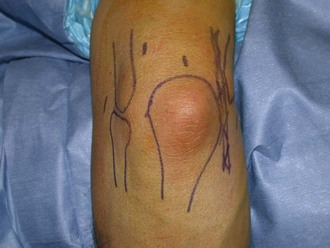Chapter 45 • Traumatic onset (usually minor trauma) aggravated by repetitive motion. • Insidious onset—chronic repetitive wrist and elbow motion at work or recreationally. • Tenderness directly over the origin of the ECRB on the lateral epicondyle. • Aggravation of symptoms with active resisted wrist extension and passive wrist flexion. • Often previously treated with nonoperative measures. • Pain with range of motion of the elbow and clicking may point to associated joint disease. The patient is positioned prone with the arm hanging over the side in 90 degrees of abduction and neutral rotation (Fig. 45-1). Care needs to be taken that the arm is not abducted more than 90 degrees and that the shoulder is not hyperextended, to minimize the risk of neurovascular complications. A nonsterile tourniquet is used with inflation pressures of 200 to 250 mm Hg according to the size of the arm and systolic blood pressure. The procedure can be performed with the surgeon either standing or seated, and the operating table is adjusted accordingly.
Arthroscopic Treatment of Lateral Epicondylitis
Preoperative Considerations
Typical History
Physical Examination
Surgical Technique
![]()
Stay updated, free articles. Join our Telegram channel

Full access? Get Clinical Tree


Arthroscopic Treatment of Lateral Epicondylitis







